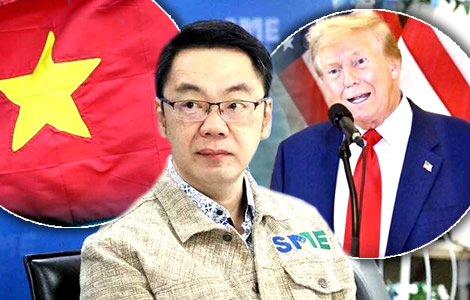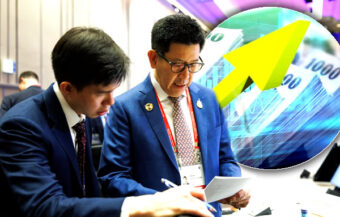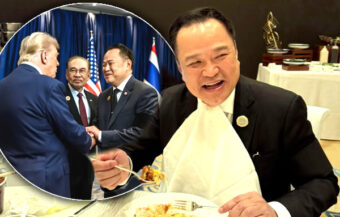Thai SMEs sound alarm as US imposes 36% tariffs, risking 3.7M jobs and 5,000 factories. Vietnam gains edge with 0% tariffs, deepening trade gap. Government pressured to act fast on Chinese ties and looming economic crisis threatening Thailand’s export future.
Thailand is losing ground fast in high-stakes trade talks with the United States. As pressure mounts, the risks are skyrocketing—and so are the demands. Over the weekend, Thai SMEs sounded the alarm, warning the government that this is nothing less than an existential crisis. Meanwhile, Vietnam—Thailand’s fiercest regional rival—is pushing hard for a better deal: a 10–15% tariff rate plus most-favoured-nation treatment. Worse, Vietnam has already handed Washington a golden ticket—zero-per cent tariffs on US imports. That’s now the baseline for American negotiators. It’s also a deal China already enjoys for many goods under regional trade pacts. The message from Washington is clear: Thailand must step up—or step aside.

Thailand is facing a growing crisis over U.S. trade tariffs. The sudden imposition of a 36% import tariff by the United States has left Thai officials scrambling for solutions. This unexpected move could seriously disrupt Thailand’s manufacturing sector. Notably, small and medium-sized enterprises (SMEs) are especially vulnerable.
At the heart of the issue is Vietnam. That country has emerged as a direct competitor to Thailand. Vietnam offers cheaper labour, lower overheads and better international trade access.
As a result, U.S. firms are increasingly favouring Vietnam for supply chain relocation. Consequently, Thailand risks losing its edge in the Southeast Asian export market.
Vietnam deepens trade advantage over Thailand as U.S. tariff hike threatens SME survival and exports
Furthermore, Vietnam recently secured a provisional trade deal with the United States. Initial negotiations suggested tariffs in the 10–15% range. However, Trump’s public announcement of a 20% tariff took Vietnamese negotiators by surprise. Despite the confusion, Vietnam still holds an advantage over Thailand. This discrepancy has widened the competitive gap.
In contrast, Thailand faces a punishing 36% tariff rate. Unless addressed quickly, this will erode its position in the U.S. market. Over the weekend, Thai SMEs warned that up to 5,000 factories and 3.7 million jobs are at risk. Many of these businesses lack the resilience to absorb such sudden cost increases.
Moreover, foreign investors are beginning to respond. Reports indicate that U.S. and Chinese firms are delaying or even shifting production to Vietnam. This trend spells danger for Thailand’s already fragile export sector.
Additionally, the economic hit is expected to be severe. Kasikorn Research Centre warns that GDP could contract by 1.1% this year. If the tariff stays in place, the economy might shrink by as much as 4.5% in the second half of 2025.
Thai SMEs face collapse and GDP decline as investment shifts to Vietnam amid rising U.S. tariffs
Therefore, the government is under immense pressure to respond. Thai SME Federation President Napapong Thiraworn has urged immediate relief. He emphasised that Thai firms are already seeing order cancellations and price renegotiations. In particular, companies that export indirectly via traders are at serious risk.
Importantly, Thailand’s competitors are taxed at much lower rates. Vietnam is facing 20%, Malaysia 25%, Indonesia 32%, and Japan and South Korea just 25%. Thai exporters must now offer steep discounts to remain viable. For many SMEs, this is simply unsustainable.
Hence, Napapong is calling for urgent support. He suggests working capital loans, new regional markets and innovation incentives. These steps, he argues, could help SMEs stay afloat and compete globally.
Nonetheless, there is a deeper issue at play. Thailand’s economic alignment with China has raised eyebrows in Washington. Over recent years, Thailand has grown closer to Beijing. Meanwhile, Vietnam has actively courted U.S. trade partnerships.
Government urged to act fast as SMEs call for aid and China ties strain relations with Washington
China’s recent push to finalise the ASEAN Free Trade Zone 3.0 further complicates matters. This deal includes the digital economy and green initiatives. Although meant to enhance cooperation, it could undermine Thailand’s bargaining position with the U.S.
Additionally, Chinese firms have been accused of abusing trade loopholes. Some companies reportedly operate in Thailand without permission. Others use nominee shareholders to skirt local ownership rules. These practices strain Thailand’s regulatory system and irritate Western partners.
The Regional Comprehensive Economic Partnership (RCEP), which came into force for Thailand in 2022, has also drawn criticism. The agreement gives Chinese firms easier access to Thai markets. Critics argue it has disadvantaged local businesses while offering little in return.
Amid these tensions, former Prime Minister Thaksin Shinawatra has stepped back into the spotlight. On Friday, he was reportedly consulted for advice on navigating these complex negotiations. Thaksin, known for his bluntness, has openly conceded China’s pressure on Thailand.
China’s influence raises U.S. concerns as Thaksin returns to help navigate deepening trade conflict
As talks continue, the U.S. has issued further demands. Not only does Washington want tariff relief, but it also seeks assurances against Chinese transshipment. The U.S. wants stronger measures to prevent indirect Chinese exports via Thailand. These so-called transshipment arrangements allow Chinese goods to enter U.S. markets disguised as Thai exports.
Additionally, the U.S. is concerned about unfair manufacturing practices. Some Chinese firms are believed to exploit Thailand’s regulatory loopholes. The Americans want to see reforms in factory oversight and trade transparency.
Interestingly, one detail has alarmed Thai negotiators. Vietnam has offered the U.S. a 0% tariff on all imports, including product precursors. This has reportedly become a key point for U.S. negotiators. Thailand has made no such offer.
This bold Vietnamese move has shifted the playing field. It sends a strong message about Vietnam’s willingness to deepen ties with the U.S. Under Communist Party boss To Lam, Vietnam is positioning itself as Southeast Asia’s most U.S.-friendly economy. Thailand, once the region’s go-to partner, has lost ground.
Vietnam won U.S. favour with bold concessions, as Thailand struggles to meet growing demands
The Trump administration sees this as part of a larger realignment. Since 2017, U.S. trade policy has moved away from China and toward alternative allies. Trump’s second presidency is pushing this strategy even further. According to officials, this is not mere political theatre—it is a strategic overhaul.
The stakes are enormous. If Thailand fails to act, it could lose not just factories and jobs, but also long-term credibility. Western nations tend to follow U.S. trade leadership. Losing U.S. favour may cause ripple effects across the global investment community.
Over the past week, Thai ministries have scrambled to draft counterproposals. A new plan was submitted to the U.S. on July 6. Thai officials hope to bring tariffs down below 36%. The Joint Standing Committee on Commerce, Industry, and Banking (JSCCIB) supports the new proposal.
According to JSCCIB Chairman Poj Aramwattananon, the plan balances national interest with international competitiveness. It also considers the needs of small businesses and farmers. However, he warns that failure to secure a competitive rate could devastate exports.
Thai ministries scramble to reverse tariffs as Trump reshapes U.S. trade alliances in Southeast Asia
Meanwhile, Kasikorn Research has highlighted another risk. If Thailand agrees to import U.S. pork and offal as part of the deal, it could lose ฿112 billion. The country’s pork market would be swamped by cheaper U.S. imports. Thai farmers, slaughterhouses and feed producers would be hit hardest.
U.S. pork sells for $1.70 per kilogram. Thai pork costs $2.30—about 1.3 times more. Accepting U.S. pork would therefore crush domestic prices and potentially force mass closures. Over 149,000 pig farmers could be affected.
This adds further pressure to already strained Thai agriculture. The government must weigh trade concessions against rural livelihoods. Any misstep could trigger political backlash.
At the same time, product-specific disadvantages are mounting. Thai transformers, video cameras, and processed fish may lose out to Vietnam. Malaysia could overtake Thailand in printers and electrical machinery. Indonesia is threatening Thailand’s shrimp and electronics market share. Even Japanese and Korean air conditioners may outcompete Thai versions.
So far, government action has been limited. SMEs say time is running out. They urge quick implementation of relief measures. These include grants, innovation programs, and regional trade expansion. Above all, they want tax parity with competitors.
Farmers and SMEs face rising threats as U.S. pork imports and regional rivals undercut Thai exports
The broader message is clear. Thailand must adapt or fall behind. A 36% tariff is not just an economic burden. It symbolises a shift in how the U.S. views Thailand’s economic policies and alliances.
According to Napapong, market diversification is key. SMEs must reduce reliance on the U.S. and explore ASEAN, Middle Eastern and African markets. Innovation, especially in digital goods and green tech, is also essential.
Thaksin joins Thai tariff crisis talks at Phitsanulok Mansion. Confirms real fears of Chinese retaliation
Thailand still in denial about the gravity of its position as the US effectively downgrades it economically
Thaksin stoutly defends Prime Minister Ung Ing and blames the 2017 Constitution for thwarting progress
Vietnam becomes the US partner of choice while Thailand is gutted with a 36% tariff and is left the big loser
To succeed, Thailand must also rebuild trust with U.S. stakeholders. Transparency, compliance and strategic clarity are non-negotiable. This is a make-or-break moment for Bangkok.
Indeed, the Trump tariff regime presents both a threat and an opportunity. Thailand can choose to resist change or embrace reform. The decisions made now will shape the kingdom’s economic future for decades.
With global supply chains shifting and protectionism rising, standing still is not an option. It is decision time in Bangkok. And the world is watching.


















